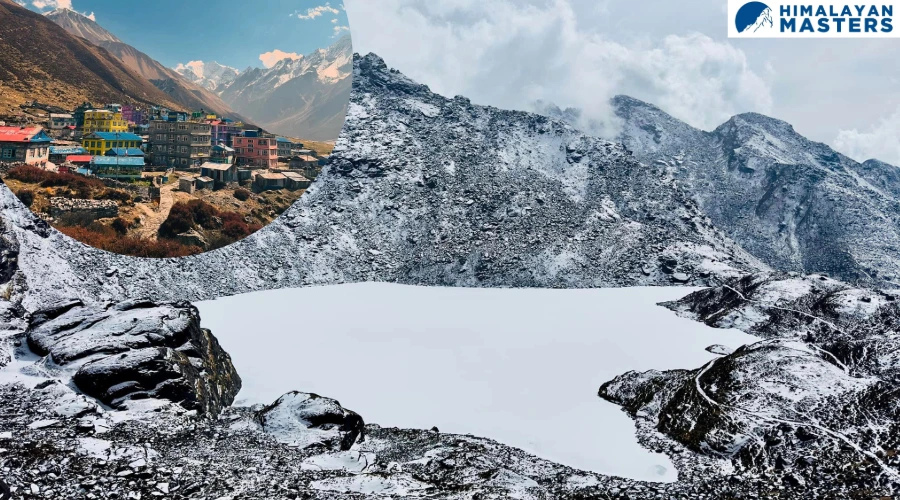
Langtang Gosaikunda Trek- 12 Days
If you are looking for the best tours to the beautiful pristine lake, scenic mountains, unique landscape, and culturally blessed villages, this Langtang Gosaikunda Trek is your type. Get ready to have an excellent memory.
This Langtang Gosainkunda Trek has been underrated for a century. This beautiful tea house trekking experience is close to the capital of Gosainkunda, a holy lake for Buddhist and Hindu pilgrimage.
Over centuries, Nepalese people have set an arduous journey to this sacred lake, and now it’s open to the public. In August, during Janai Purnima, thousands of people are praying here. Besides the lake, you can walk via Langtang and Kyanjin Gompa villages for a deep insight into the Tibetan Buddhist culture.
Langtang Gosainkunda Trek begins with a drive north of the capital, Syabru Besi village. From here, we visit the Lama Hotel and Mundu before climbing to Kyanjin Gompa. After a day here, we return to Syabru Besi and climb to Sing Gompa. Finally, we visit the beautiful settings of Gosainkunda Lake before returning to Kathmandu.
About Langtang Valley
Langtang Valley lies within the Langtang National Park of Nepal. The village has a lot to tell tourists about its strength and resilience, which they have learned in the past few years.
Most of the people who reside in Langtang Village are Sherpa and Tamang.
The people of Langtang village were devastated by the earthquake. Many people lost their lives during that time, but still, the people did not let their spirits burn. They stood out again for making the beautiful Langtang that you see today.
What is Gosaikunda?
Gosaikunda Lake is an alpine freshwater lake in Langtang National Park, Nepal. It is marked by its beauty and belongs to a cluster of lakes, of which Gosaikunda is the most famous.
Gosaikunda has a great natural appeal and is a place of pilgrimage. It attracts not only trekkers but also spiritual seekers in large numbers.
Where is Gosaikunda?
Gosaikunda is located in Rasuwa District, Bagmati Province, Nepal. It is situated within Langtang National Park, a protected area with fantastic landscapes and high biodiversity. Usually, trekking starts from Dhunche, and it takes four to five days to reach the Gosaikunda Lake.

Height of Gosaikunda Lake
It is situated at an altitude of 4,380 meters above sea level, which makes it unique in its alpine ecosystem and beautiful viewpoints. The lake itself covers approximately 13.8 hectares, and other smaller lakes, including Bhairav Kunda and Saraswati Kunda, are close by, enhancing its beauty.
History of Gosaikunda Lake
Gosaikunda Lake is a sacred lake situated at a height of about 4380 meters in the Langtang National Park, Nepal. It is very famous among Hindus and Buddhists.
Lord Shiva is believed to have dug out the Holy Water Lake with his trident, Trishul, to quench his thirsty throat after consuming poison during the Samudra Manthan and obtain the click of immortality named “Amrit.”
The lake and its vicinity are mentioned in the Ramayana and the Mahabharata, meaning the place has religious significance.
During the August festival of Janai Purnima, thousands of pilgrims from Nepal and India walk through a tough track to reach Gosaikunda and take a bath in its freezing water, believing that whoever does so washes away sins from his/her soul.
Historically, Gosaikunda has also been an important water source. There was also a halt on old trading routes from Nepal to Tibet through the Himalayas. It has become one of the top trekking destinations for enthusiasts.
Religious Importance of Gosaikunda Lake Trek
The Langtang Gosaikunda Lauribina Pass Trek is a trail of great religious importance to Hindus and Buddhists alike. According to the devotees, this holy water keeps them free from evil deeds and gives them merits for their afterlife.
Most devotees visit for rituals during Janai Purnima in August, tying sacred threads around their wrists and offering something at the lakeside. Thus, the trek itself becomes a kind of spiritual journey, and many feel it to be a rite of passage.
About Gosaikunda Temple
Behind the Gosaikunda temple is the ancient Gosaikunda lake, which is devoted to Lord Shiva. The temple has various stone carvings, which attract pilgrims who want to worship and offer prayers.
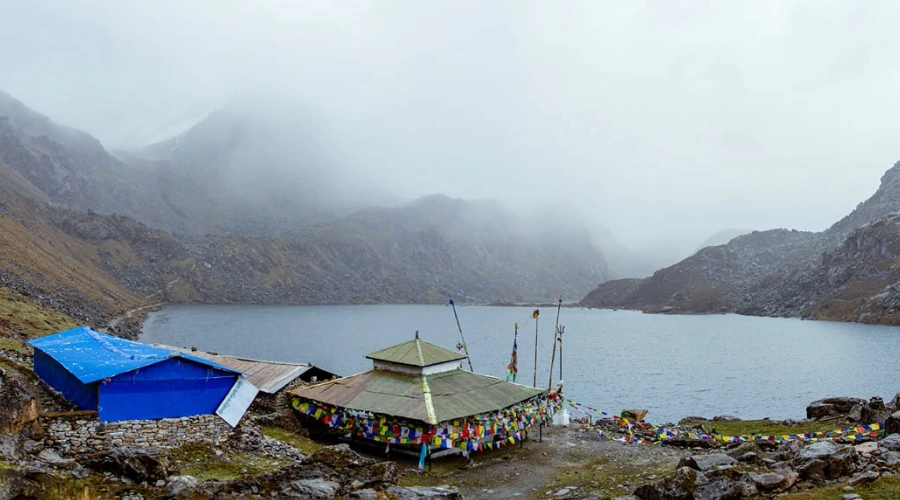
The temple is very busy with festivals when people come here to offer flowers, fruits, and other items in the temple’s area. The peaceful environment of the temple’s surroundings adds to its spiritual importance. It is a centre of attraction for those eager to enjoy adventure and have a spiritual penchant.
Trekking Experience in Langtang Gosaikunda Lake
Langtang Gosaikunda Lauribina Pass Trek is a different itinerary that combines natural surroundings with spiritual features. From Dhunche, walking up through forests and pleasant villages, one eventually reaches the beautiful Gosaikunda Lake at 4,380 meters (14,370 ft.). The alpine lake is surrounded by high mountains and is known for its water, which is viewed as sacred by both Hindus and Buddhists.
Gosaikunda Lake
Gosaikunda Lake is the main highlight of the trek, and many people refer to it as one of the holiest and purest lakes in Nepal. Legend says it was created by Lord Shiva when he pierced the mountain with his holy Trident to take away poison he had drunk while churning the ocean.
The Gosaikunda Lake represents a complex containing 108 different holy lakes, each with significance and stories to tell from the local mythology.
Holy Lakes
The Gosaikunda trek surrounds several other sacred lakes, such as Saraswati Kunda and Bhairab Kunda. During festivals such as Janai Purnima, thousands of devotees gather. They immerse themselves in the waters to rid themselves of sin and sorrow. This spiritual atmosphere elevates the physical satisfaction of trekking.
Red Panda and Snow Leopard
Moreover, the Langtang Gosainkunda Trek offers the chance to see rare wildlife like the red panda and snow leopard. The Himalayas have many fauna, including the Himalayan black bear, musk deer, and many bird species.
While crossing the broad biodiversity of Langtang National Park, trekkers may have an opportunity to glance at these species, which will make the hike entertaining.
Laure binayak Pass and Lauri Binayak
On the way to Gosaikunda, trekkers must cross the Laure Binayak Height pass, 4,610 meters (15,120 feet) above sea level. The pass is the door to Gosaikunda and is a milestone for most trekkers. Local people call it Laurebinayak because of its steep ascent, like climbing a stick.
Tamang Heritage Trail
The Tamang Heritage Trail lies in the Langtang region of Nepal. It is a cultural trekking trail that showcases the rich traditions and livelihoods of the Tamangs, one of the ethnic groups of Nepal famous for their culture and friendly hospitality.
This Tamang Heritage trek is unforgettable due to the variety of landscapes and stunning views of the Himalayas, such as the peaks of Langtang Lirung and Ganesh Himal.
Langtang Gosaikunda Trek Facts
- Beginning/Ending Point: Kathmandu, Nepal (1400 m)
- Trek Beginning Point: Syabrubesi (1503 m / 4931 ft.)
- Trek Ending Point: Dhunche (1960 m / 6430 ft.)
- Trek Distance: Approximately 77 km / 48 miles
- Maximum Altitude: 4985 m / 16356 ft. (Tserko Ri)
- Trek Duration: 12 Days
- Permits: TIMS Card and Langtang National Park entrance permit
- Mode of Transportation: Jeep or bus from Kathmandu to Syabrubesi
- Best Time to Visit: Autumn (September to November) and Spring (March to May)
Highlight of Langtang Gosainkunda Trek
- Panoramic vistas of the Langtang Himal, Ganesh Himal, and Annapurna ranges.
- Visit the sacred Gosaikunda Lake, a major pilgrimage site for Hindus.
- Interact with the Tamang and Sherpa communities along the trek.
- Explore the beautiful Langtang Valley, known for its stunning landscapes and wildlife.
- Visit Kyanjin Gompa, a remote monastery famous for yak cheese production.
- Hike to Tserko Ri, located at an altitude of 4985 meters.
- Trek through varied ecosystems, including rhododendron forests and alpine pastures.
Culture and Wildlife in Gosaikunda Trek
The inhabitants are mainly the Tamang ethnic group, who have unique customs and speak a native dialect. Trekkers will notice signs of Tibetan influences in wayside villages lining the trail, which have prayer flags and monasteries.
Gosaikunda Lake is considered a holy place for Hindus and Buddhists, attracting many pilgrims. Through lush forests and alpine meadows, the Langtang Gosainkunda Trek will take one to spot the red panda, Himalayan black bear, and many birds.
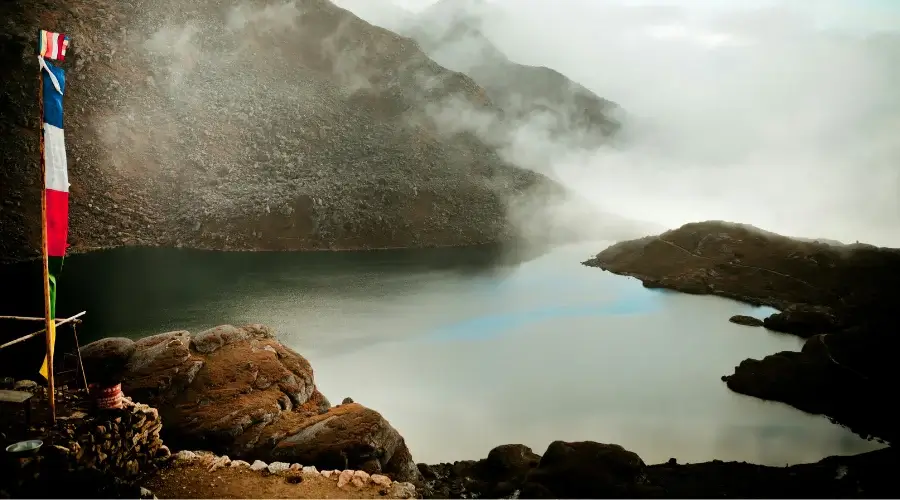
A typical day on the Gosaikunda Lake Trek
As with the other treks, a normal Langtang Gosaikunda trek itinerary begins with waking up early for breakfast from a teahouse or lodge. Trekkers next begin their trek, usually early in the morning, around 7-8 AM, passing through villages/forests and some beautiful mountains. The break is usually taken in the mid-morning at a teahouse.
If a lodge is available in the region, it is also taken mid-morning. After the meal, trekkers take a break to charge their energy and sleep before addressing activities to be done the next day.
Gosaikunda Helicopter Tour
The Gosaikunda Helicopter Tour is a quick way to reach this holy lake without a tiring trek. The helicopter ride from Kathmandu takes about 15-20 minutes and offers panoramic views of the Langtang Himalayan range.
On landing at Gosaikunda Lake, passengers can expect 30 to 45 minutes for sightseeing, photography, or worship.
This trek is highly appropriate for those with a very short time or equally low physical fitness level. It saves enough time to travel into the most sacred Gosaikunda region without much hiking.
Essential Notes for Gosaikunda Lake Trek
- Because there can be high altitudes, proper acclimatization would be essential for avoiding altitude sickness.
- Generally, trekking goes best in March, April, May, or September to November.
- Trekkers require a TIMS card and permission from Langtang National Park.
- The physical fitness level is average because all the sections can sometimes be rough.
- Pack in warm clothes, good hiking boots, and necessary trekking gear.
- Do not forget to bring water purification tablets and snacks along.
- Respect the customs and practices of the locals very much when visiting religious places.
The Itinerary Outline Table of 12 days Langtang Gosaikunda Trek
| Day | Itinerary | Altitude Gain | Time/Distance |
| 01 | Drive to Syabrubesi | 1503 m / 4931 ft. | 7-8 hr/122 km |
| 02 | Trek to Lama Hotel | 2480 m / 8136 ft. | 5-6 hr/12 km |
| 03 | Trek to Langtang Village | 3430 m / 11253 ft. | 4-5 hr/14.8 km |
| 04 | Trek to Kyanjin Gompa | 3870 m / 12697 ft. | 3-4 hr/6.8 km |
| 05 | Rest Day (Hike to Tserko Ri) |
4985 m / 16356 ft. | 7-8 hr/10 km (Round) |
| 06 | Trek Back to Lama Hotel | 2480 m / 8136 ft. | 5-6 hr/21.6 km |
| 07 | Trek Back to Thulo Syabru | 2210 m / 7250 ft. | 5-6 hr/10-11 km |
| 08 | Trek to Sing Gompa | 3330 m / 10925 ft. | 5-6 hr/16 km |
| 09 | Trek to Gosainkunda Lake | 4,380 m / 14,370 ft. | 4-5 hr/8 km |
| 10 | Trek Back to Sing Gompa | 3330 m / 10925 ft. | 3-4 hr/8 km |
| 11 | Trek to Dhunche | 1960 m / 6430 ft. | 4-5 hr/8.3 km |
| 12 | Drive to Kathmandu | 1400 m / 4593 ft. | 6-7 hr/120 km (Approx.) |
Things to view during the trek
We witness over a dozen mountain peaks during the trek, including Langtang Lirung, Langsisa, Dorje Lakpa, Langtang Ri, Ganjala Peak, and more. Next, we will witness an incredible bio-diversity of sub-tropical and arid vegetation within a diverse landscape.
The wild animals in the region make your tour even more enjoyable. We will also see monasteries, stupas, mani walls, rotating wheels, and many Buddhist cultural events. Gosainkunda Lake is the main highlight of the famous Gosaikunda Trek.
Detailed itinerary
Day 01: Drive from Kathmandu to Syabrubesi (1503 m)
Trek Route: Kathmandu → Trishuli Bazaar → Dhunche → Syabrubesi
Beginning Point: Kathmandu (1400 m / 4593 ft.)
Ending Point: Syabru Besi (1503 m / 4931 ft.)
Kathmandu to Syabrubesi Distance: 122 km/75.8 miles
Total Ascent: 103 m
Lunch: Trishuli Bazaar
Overnight: Syabrubesi
Now, it’s time to head towards the Mountains. So, an early morning ride takes us along Nepal’s hilly, winding road. Beyond many small settlements, rivers, and waterfalls, we get to Syabrubesi. Here, you can live a day in a local hotel and prepare for a fantastic journey.
As you ascend, the air gets crisp and clean. You’ll see breathtaking views of the terraced hillsides, where locals have carved out their homes and farms amidst the steep slopes.
We’ll stop for lunch at a local restaurant, allowing you to experience the local cuisine and interact with friendly locals. The food will be simple but delicious, featuring traditional Nepali dishes.
In the late afternoon, we’ll reach Syabrubesi, a small village that serves as the starting point for our Langtang trek. Syabrubesi is a charming village with a relaxed atmosphere and friendly locals.
Tea House in Syabrubesi:
– Around 10-15 teahouses.
– They have basic amenities like Wi-Fi, electricity, and more.
– You can also get a hot shower free of cost.
Meal : Breakfast, Lunch and Dinner
Accomodation : Tea House
Walking / Driving : 7-8 hours driving
Day 02: Trek from Syabrubesi to Lama Hotel (2480 m)
Trek Route: Syabrubesi → Ghopcha Khola → Pahiro → Bamboo → Rimche → Lama Hotel
Beginning Point: Syabru Besi (1503 m / 4931 ft.)
Ending Point: Lama Hotel (2480 m / 8136 ft.)
Total Ascent: 977 meters (3205 ft.)
Syabrubesi to Lama Hotel Trek Distance: 12 km/ 7.4 mi
Lunch: Bamboo
Overnight: Lama Hotel

Our initial trekking journey begins from Syabrubesi. In the morning, we walk to a bridge over the Langtang River. Then, we pass via the sub-tropical forest of Rhododendron, Pine, and Bamboo. Climbing slowly above the river, our days end at the Lama Hotel.
We’ll first glimpse the majestic Langtang Lirung, the highest peak in the Langtang range. You’ll also see other impressive peaks, including the Ganesh Himal range.
The trail climbs steadily, but the scenery is well worth the effort. We’ll stop for lunch at a beautiful spot along the river, enjoying a picnic-style lunch with views of the mountains.
In the afternoon, we’ll continue our trek, eventually arriving at Lama Hotel, a quaint village nestled amidst the towering peaks.
Tea House in Lama Hotel:
– Lama Hotel has 5-6 teahouses.
– You will find basic services here.
Also, read another route here: Helambu Trekking Nepal.
Meal : Breakfast, Lunch and Dinner
Accomodation : Tea House
Walking / Driving : 5-6 hours walking
Day 03: Trek from Lama Hotel to Langtang Village (3430 m)
Trek Route: Lama Hotel → Riverside → Ghodatabela → Thangshyap → Langtang Village
Beginning Point: Lama Hotel (2480 m / 8136 ft.)
Ending Point: Langtang Village (3430 m / 11253 ft.)
Total Ascent: 950 meters (3116 ft.)
Lama Hotel to Langtang Village Distance: 14.8 km/9.1 miles
Lunch: Ghodatabela
Overnight: Langtang Village

This is a short and exciting walk to the Langtang Village. Walking with stunning Mt. Langtang Lirung before us, we first get to Ghoda Tabela.
Entering the Langtang National Park, we witness more amuses of Langtang. However, as we enter the Langtang Village, the impact of the 2015 earthquake will be visible.
You’ll walk through various landscapes, including lush forests, open meadows, and rocky trails. Keep an eye out for colourful wildflowers blooming along the way, adding to the vibrant scenery.
The trail continues through the park, and as you approach Langtang Village, you’ll begin to see the impact of the 2015 earthquake. The village was severely affected, and you’ll witness the ongoing rebuilding efforts.
About Ghoda Tabela:
We’ll reach Ghoda Tabela, a small settlement, before entering the Langtang National Park. This is a good spot to stop for a break and take in the panoramic views.
About Langtang Village:
Langtang Village is a traditional settlement located at 3430 meters (11253 ft.). The village is home to the Tamang people, and its Buddhist culture is evident through the many prayer flags, chortens, and monasteries scattered around.
Despite the destruction, the spirit of the Langtang Village people is strong. They’re rebuilding their homes and lives, and you’ll see a sense of community and resilience that’s inspiring.
Tea House in Langtang:
– Langtang Village offers several teahouses from which to choose.
– Some popular options include Langtang Lodge, Langtang Village Guest House, and Hotel Langtang Village.
– They provide comfortable lodging and delicious food.
– You will get facilities like Wi-Fi, a hot shower, and everything.
Meal : Breakfast, Lunch and Dinner
Accomodation : Tea House
Walking / Driving : 4-5 hours walking
Day 04: Trek from Langtang Village to Kyanjin Gompa (3870 m)
Trek Route: Langtang Village → Mundu → Sindum → Yamphu → Kyanjin Gompa
Beginning Point: Langtang Village (3430 m / 11253 ft.)
Ending Point: Kyanjin Gompa (3870 m / 12697 ft.)
Total Ascent: 440 meters (1444 ft.)
Langtang Village to Kyanjin Gompa Trek Distance: 6.8 km/4.2 miles
Lunch: Kyanjin Gompa
Overnight: Kyanjin Gompa
Today, we walk via many villages, yak pastures, and streams to Kyanjin Gompa. This white-washed old monastery of Langtang holds great significance to the people of Langtang.
The trail follows the Langtang Khola (river), and you’ll see the river rushing alongside you as you trek. This is a popular spot for spotting wildlife, so keep your eyes peeled for yaks, blue sheep, and various bird species.
As you ascend, the views become even more impressive. You’ll see the majestic Langtang Lirung towering above the valley, with other peaks surrounding you.
Kyanjin Gompa:
We’ll reach Kyanjin Gompa, a picturesque village with a white-washed monastery. The gompa (monastery) is an important site for the local Buddhist community and is a great place to learn about Tibetan Buddhist culture.
Tea House in Kyanjin Gompa:
– Kyanjin Gompa has a few teahouses providing comfortable accommodations with amazing views.
– Some popular options include Kyanjin Gompa Lodge, Langtang Lodge, and Tserko Ri Lodge.
– You’ll also find several small shops and restaurants in the village.
Meal : Breakfast, Lunch and Dinner
Accomodation : Tea House
Walking / Driving : 3-4 hours walking
Day 05: Acclimatization Day at Kyanjin Gompa- Hike to Tserko Ri (4985 m)
Hike Route: Kyanjin Gompa → Tserko Ri → Kyanjin Gompa
Beginning/Ending Point: Kyanjin Gompa
Highest Point: Tserko Ri (4985 m / 16356 ft.)
Total Ascent: 1115 meters (3658 ft.)
Kyanjin Gompa to Tserko Ri Hiking Distance: 10 km (round trip)
Lunch: Packed lunch (during hike)
Overnight: Kyanjin Gompa
Our plan for the day is to hike up to Tserko Ri in the morning. This hilltop lies at 5000 meters above sea level, and the sunrise from the top looks mesmerizing. It’s also the best viewpoint for the panorama of Langtang Himal.
As there are no teahouses or lodges on the way to Tserko Ri, we must pack our lunch and water. Make sure to carry enough snacks and water for energy.
The route is all the way uphill as we will climb Tserko Ri. After exploring the peak and seeing the mesmerizing view of Langtang, Langtang Lirung, Shishapangma, and many other peaks, we will make our way down to Kyanjin Gompa.
We explore the Kyanjin Gompa in the evening and learn more about Buddhist culture.
Meal : Breakfast, Lunch and Dinner
Accomodation : Tea House
Walking / Driving : 7-8 hours (Round trip)
Day 06: Trek back to Lama Hotel from Kyanjin Gompa
Trek Route: Kyanjin Gompa → Langtang Village → Thangshyap → Ghodatabela → Lama Hotel
Beginning Point: Kyanjin Gompa (3870 m / 12697 ft.)
Ending Point: Lama Hotel (2480 m / 8136 ft.)
Total Descent: 1390 meters (4561 ft.)
Kyanjin Gompa to Lama Hotel Trekking Distance: 21.6 km/13.4 miles
Lunch: Ghodatabela
Overnight: Lama Hotel
So, now we plan to trace the same route back to Lama Hotel. On the way to the Lama Hotel, Langtang Khola will walk with us. During the spring season, we can see the beautiful rhododendron forest all over the way. Then we will reach Langtang Village after walking for an hour.
Then we will reach Ghoda Tabela, where we will have lunch. After resting for a while, we will move towards the riverside, a teahouse area along the river’s shore. It has one of the majestic jungles and river views. On the way down, we might spot some wild animals and birds.
We reach Lama Hotel by night and stop here. We will stay at the same hotel where we stayed during the trek.
Meal : Breakfast, Lunch and Dinner
Accomodation : Tea House
Walking / Driving : 5-6 hours walking
Day 07: Trek back to Thulo Syabru from Lama Hotel
Trek Route: Lama Hotel → Rimche → Bamboo → Domen → Thulo Syabru
Beginning Point: Lama Hotel (2480 m / 8136 ft.)
Ending Point: Thulo Syabru (2210 m / 7250 ft.)
Total Descent: 270 meters (885 ft.)
Lama Hotel to Thulo Syabru Trekking Distance: 10-11 km/ 6.7 mi
Lunch: Bamboo
Today, we’ll continue our descent, hiking back to Thulo Syabru. The trail is the same one we took on our way to Lama Hotel, but we’ll be going downhill, making it a relatively easy trek. Earlier in the trek, we had stayed in Syarbrubesi, but this time, we will stay at Thulo Syarbru.
We will make our way down to bamboo. Then, after crossing the river, we will move towards Pahiro. Pahiro means landslide in Nepali language. The place is named Pahiro because the place is prone to landslides.
We will have our lunch at Pahiro. There are around 3 teahouses in Pahiro. There is also one small hot spring near Pahiro known as Tatopani.
As we descend, the air will get warmer, and the vegetation will become denser. You’ll see a variety of trees and flowers, and you might even spot some wildlife along the way.
Then, after hiking for more than 2 hours, we will reach our destination, Thulo Syarbru.
About Thulo Syabrubesi:
Thulo Syarbrubesi is a small village in the Langtang National Park of Nepal. You will find schools, health posts, police posts, and national Park check posts.
There are around 50-60 local houses of people, excluding the teahouses. Most of the people are engaged in tourism. The major source of income for the people is either tourism or agriculture.
Teahouse of Thulo Syabrubesi:
– Around 10-15 teahouses.
– Have a good facility of accommodation.
– Attached are the bathrooms, Wifi, electricity, and hot shower.
Meal : Breakfast, Lunch and Dinner
Accomodation : Tea House
Walking / Driving : 5-6 hours walking
Day 08: Trek from Thulo Syabru to Sing Gompa (3330 m)
Trek Route: Thulo Syabru → Dursagang → Phulung Danda → Sing Gompa (Chandanbari)
Beginning Point: Syabrubesi (1503 m / 4931 ft.)
Ending Point: Sing Gompa (3330 m / 10925 ft.)
Total Ascent: 1120 meters (3674 ft.)
Trekking Distance: 16 km/10 miles
Lunch: Dursagang
Overnight: Sing Gompa (Chandanbari)
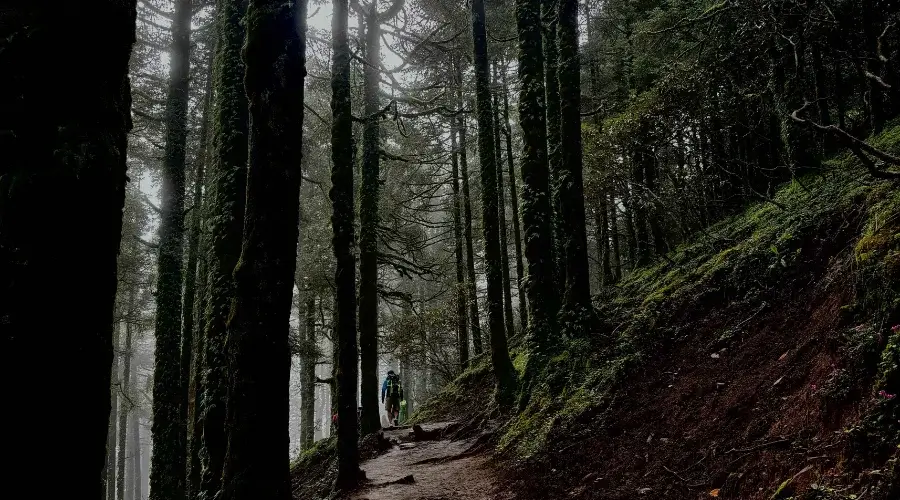
The trail will take us through various landscapes, including lush forests, open meadows, and rocky trails.
You’ll pass through the small village of Thulo Syabru and continue to the villages of Dursagang and Phoparng Danda, allowing you to experience the beauty of the Tamang culture.
There are around 2 teahouses in this area. After hiking for 3-4 hours, you will reach the top. The route is all the way uphill.
As we hike, we’ll have magnificent views of the Ganesh Himal range, a stunning cluster of peaks in the distance. The air will be crisp and clean, and the silence of the mountains will be broken only by the sound of the wind through the trees.
We’ll reach Sing Gompa in the late afternoon, a small village in a beautiful valley. Sing Gompa is a traditional Tamang village known for its Buddhist monastery and local cheese factory. You can explore the village and learn about the local culture.
About Sing Gompa:
Sing Gompa, also known as Chandanbari, is a small village in the Langtang region of Nepal. It is famous for its old Buddhist monastery, Sing Gompa, which is important to local people.
The village offers beautiful views of the mountains and has a yak cheese factory where you can try and buy tasty yak cheese. Sing Gompa is a great place for trekkers to rest, with cozy lodges and a peaceful environment, making it a nice stop on the way to Gosaikunda Lake.
Teahouses in Sing Gompa:
– Good services such as Wi-Fi, electricity, and hot shower.
– Around 4-5 teahouses.
This Langtang Trek Guide page can help your trip.
Meal : Breakfast, Lunch and Dinner
Accomodation : Tea House
Walking / Driving : 5-6 hours walking
Day 09: Trek from Sing Gompa to Gosainkunda Lake (4,380 m / 14,370 ft.)
Trek Route: Sing Gompa → Cholang Pati → Laurebinayak → Buddha Mandir → Gosainkunda
Beginning Point: Sing Gompa (3330 m / 10925 ft.)
Ending Point: Gosainkunda Lake (4380 m / 14370 ft.)
Total Descent: 1050 meters (3445 ft.)
Sing Gompa to Gosaikunda Distance: 8 km/ 5 miles
Lunch: Laurebinayak
Overnight: Gosainkunda

Get excited for the incredible journey of your life. First, we will pass through Cholang Pati after walking a steep ascent for 2 hours. Some people even have lunch here.
As we walk above Lauri Binayak, we can witness a significant change in the landscape. After a 1.5-hour walk, we will reach the place. This is known as one of the best viewpoints for a grasping view. You can view Tamanag Heritage Trail, Langtang Valley, Annapurna, and so on.
Seeing the view of Langtang Lirung beyond the valley. Then, after having lunch and walking for 2 hours, we will reach our dream destination. The route is equal ascents and descents. While reaching Gosaikunda, you will find various lakes. Some are Bhairav lake, Kaalo Lake.
Then, we get to the holy lake of Gosainkunda. This sacred lake created by Lord Shiva is our stop for the night.
About Gosaikunda in Short:
Gosaikunda Lake is a beautiful mountain lake in the Langtang National Park of Nepal. It is located 4,380 meters high and surrounded by tall, rugged mountains.
This lake is vital to both Hindus and Buddhists, attracting many pilgrims, especially during the Janai Purnima festival in August. The clear waters, peaceful surroundings, and spiritual feel make Gosaikunda Lake a special place for trekkers and pilgrims.
Teahouse of Gosaikunda:
– Around 4-5 teahouses with basic facilities.
– During peak season, you might have to sleep in the dining room.
– You will get basic services like a bucket hot shower, Wi-Fi and charging.
Meal : Breakfast, Lunch and Dinner
Accomodation : Tea House
Walking / Driving : 4-5 hours walking
Day 10: Trek back to Sing Gompa from Gosainkunda
Trek Route: Gosainkunda → Buddha Mandir → Laurebinayak → Cholang Pati → Sing Gompa
Beginning Point: Gosainkunda Lake (4380 m / 14370 ft.)
Ending Point: Sing Gompa (3330 m / 10925 ft.)
Total Descent: 1050 meters (3445 ft.)
Gosainkunda to Sing Gompa Trekking Distance: 8 km/ 5 miles
Lunch: Laurebinayak
Overnight: Sing Gompa
In the morning, we explore the magnificent areas of Gosainkunda Lake and Surya Peak. We will make our way down to Sing Gompa. You will pass through the holy lakes and forests. The route has steep inclines.
After passing through Cholang Pati, you’ll reach Laurebina Yak, where you can stop for lunch. From here, the views of the surrounding Himalayas become more stunning.
Clear skies offer breathtaking views of Langtang Lirung and Ganesh Himal. The trail ascends until you reach the alpine zone, where the landscape is stark but beautiful.
Meal : Breakfast, Lunch and Dinner
Accomodation : Tea House
Walking / Driving : 3-4 hours walking
Day 11: Trek from Sing Gompa to Dhunche (1960 m)
Trek Route: Sing Gompa → Chandan Bari → Dhimsa → Dhunche
Beginning Point: Sing Gompa (3330 m / 10925 ft.)
Ending Point: Dhunche (1960 m / 6430 ft.)
Total Descent: 1370 meters (4495 ft.)
Sing Gompa to Dhunche Trekking Distance: 8.3 km/ 5.3 mi
Lunch: Dhimsa
Overnight: Dhunche
This is your last day for the trek. Walking beyond the forest, we witness more langur monkeys and Himalayan animals.
First, we get to Sing Gompa Stream and cross it on a suspension bridge. Then, we hike to the village of Dhunche, where we stop at the tea house for one last time.
About Dhunche:
Dhunche is a small town in the Langtang region of Nepal and serves as the headquarters of Rasuwa District. It is the starting point for many treks, including the Langtang Valley and Gosaikunda Lake treks.
The town has basic facilities like guesthouses, shops, and restaurants, making it convenient for trekkers to prepare for their journey.
Dhunche also has schools, a hospital, a checkpost, and many government departments, providing essential services to locals and visitors. Dhunche is a pleasant stop before heading into the mountains.
Teahouse at Dhunche:
– There are around 10-15 teahouses.
– Cost may be a bit more expensive than other places.
– Can find standard to basic lodges.
– Wi-Fi, Hot shower, electricity, attached bathroom, everything can be found.
Meal : Breakfast, Lunch and Dinner
Accomodation : Tea House
Walking / Driving : 4-5 hours walking
Day 12: Drive from Dhunche to Kathmandu (1400 m)
Drive Route: Dhunche → Kathmandu
Starting Point: Dhunche (1960 m / 6430 ft.)
Ending Point: Kathmandu (1400 m / 4593 ft.)
Dhunche to Kathmandu Driving Distance: Approximately 120 km
Total Descent: 560 meters (1837 ft.)
Total Duration: 6-7 hours
Lunch: En route
The drive to Kathmandu starts in the early morning. Driving via many terraces, streams, and rivers, we get to witness the best of Nepal.
Back at the hotel, you will have some time to go souvenir shopping. Then, you will all gather for a farewell dinner, sharing beautiful memories of the trip.
Meal : Breakfast and Lunch
Accomodation : Hotel
Walking / Driving : 6-7 hours driving
Include / Exclude
Trip Cost Includes
- International Airport pick-up and drop-off service in a private vehicle
- Kathmandu to Syaprubesi and back to Kathmandu by Comfortable private jeep
- The best available clean and comfortable Tea house accommodation during the trek
- All meals (breakfast, lunch, and dinner) with tea or coffee during the trek
- Staff insurance and necessary ground transport for support staff
- Guide for all trekking days
- Trekking permits: Langtang National Park permits and TIMS Card.
- Use a 25-degree sleeping bag during the trip if needed.
- Use a pulse oximeter to check your spo2 and bpm at high elevations.
- Himalayan Masters brand water bottles and purification tablets.
- First aid kit box.
- Seasonal fruits for dessert.
- The Himalayan Masters Brand Duffle Bag for the Trip (If you hire a porter)
- Himalayan Masters Brand Trekking T-Shirt and Cap
- Emergency, one bottle of oxygen.
- All Local and Government taxes and administrative charges
Trip Cost Excludes
- Extra-night accommodation in Kathmandu in case of early arrival or late departure
- Trekking porters
- Lunch and dinner in Kathmandu
- Nepal Visa fee
- Travel and medical insurance
- International flights
- Excess baggage fee
- Personal trekking gear and equipment
- Tips for guide (tipping is expected)
Useful Info
Best Time for Langtang and Gosaikunda trek

The best time for Langtang Gosaikunda Trek is during the spring (March to May) and autumn (September to November) seasons. These periods have the most favourable weather conditions and stunning natural beauty.
Gosaikunda Trek in Spring (March to May)
The spring season on the Langtang Gosaikunda Lauribina Pass Trek is Moderate, with warm to mild temperatures. Trekkers will experience little fluctuating weather throughout the Langtang Gosaikunda Trek. The temperature during the day varies from 10 to 20 degrees Celsius; nights can be colder, especially in the mountains.
The trails are covered with rhododendrons and other flowers, creating a stunning and colourful atmosphere. The clear sky provides a good view of the Langtang Himal and other snow-capped mountains.
Gosaikunda Trek in Autumn (September to November)
After the monsoon season, Langtang Gosaikunda is warm and has fairly set weather; the clear skies give it good visibility. The daytime temperature is moderate, between 10 and 18 degrees Celsius, and nights can be really cold, particularly at higher altitudes.
The outlook of the mountains is greatly improved. There are clear skies with no pollution at all. As you follow the trail, primarily through villages, it has a cultural aspect, especially because it is harvested during autumn.
Gosaikunda Trek in Winter (December to February)
High altitudes and cool temperatures, with daytime temperatures falling between 5 to 10 degrees Celsius and night temperatures considerably low. Higher trails may prove difficult or closed during winter due to snowfall in Gosaikunda.
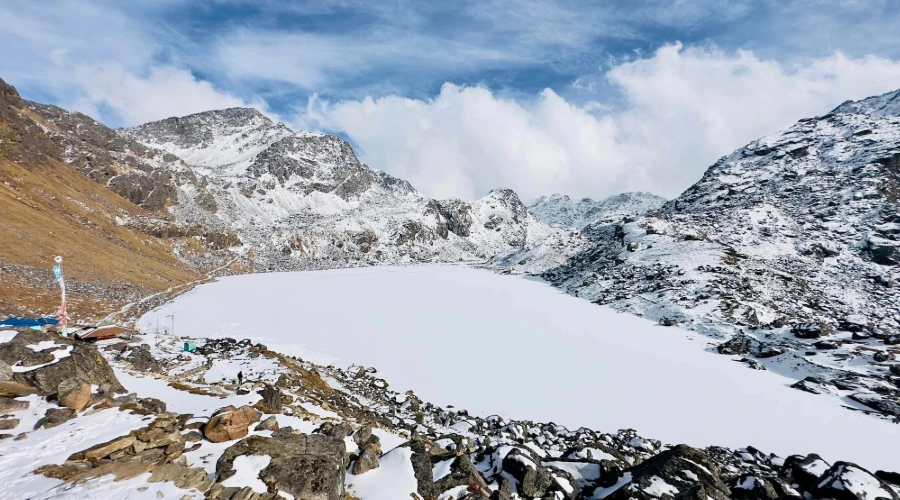
Winter scenes introduce several aesthetical appeals, especially when snow covers the ground completely. The climate is reasonably dry with much clear weather; the visibility, therefore, is good for the presence of the mountains.
Gosaikunda Trek in Monsoon (June to August)
Most of its rainfall occurs through heavy downpours, very high humidity, and cloudy weather. Generally, paths can be wrong, turning into marshland, and sometimes, the trails could be clearer. For instance, in Gosaikunda, during the Monsoon season, there is a very high tendency to experience landslides.
Because of the rains, the conditions are slippery and soggy; however, mountainous regions are often hidden from view by mist.
Weather of Gosaikunda Trek
The Langtang Gosaikunda weather may be unpleasant most of the time, especially during the season. The recommended months to visit Gosaikunda Lake are March to May and September to November for relatively mild, cool, dry weather. Winter is cold and freezing, especially in the highlands; snow makes the terrain slippery and sometimes icy.
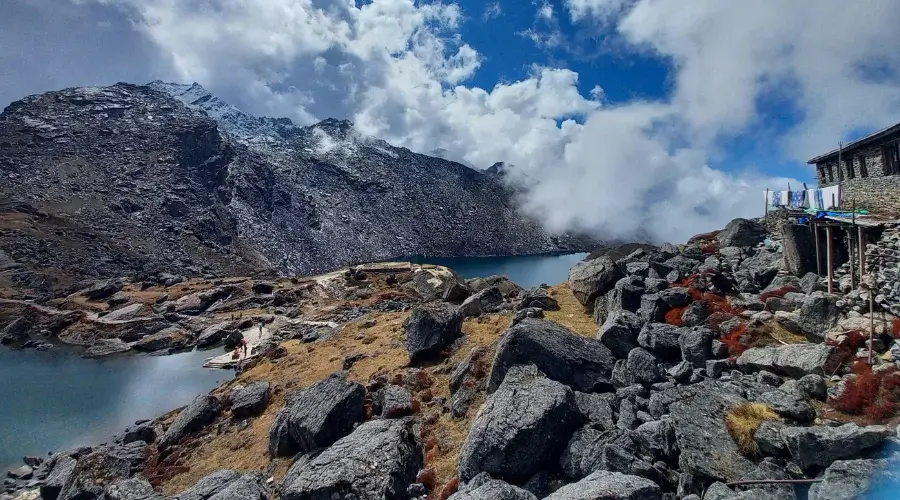
Langtang Gosaikunda Helambu trek Permits
You’ll need to obtain two permits for Langtang Gosaikunda Trek, which help manage conservation efforts and ensure safety along the trails.
TIMS Card (Trekkers’ Information Management System): The TIMS card collects trekkers’ information for safety and emergency purposes and monitors trekking activities in the region.
Cost: USD 20 for foreigners, USD 10 for SAARC nationals.
Langtang National Park Entry Permit: This permit is required to enter the Langtang National Park, which covers most of the Langtang Gosaikunda Helambu trekking route. It helps fund conservation efforts and infrastructure maintenance within the park.
Cost: USD 30 per person.
Langtang Gosaikunda Trek Cost
The Langtang Gosaikunda Trek costs around $ 1365 per person. Such costs include charges for permits, guides, porters, meals, accommodation, transport, and any other expenses incurred during the tour.
Langtang Gosaikunda trek costs should be noted and are not included in the above calculations listed in the excluded cost part. Known mitigation factors are International flights, Travel insurance, and Tips.
Additional Expenses
- Snacks.
- Additional drinks.
- Buying souvenirs during the trek or from the porters.
- Charging electronic gadgets.
- Also, warmth and hot temperatures, such as taking a hot shower.
Trip Grade: Fitness level, Medical, and Health
Langtang Gosaikunda Trek is moderate, so to go for the trek, one must be in average physical condition. On average, the trekkers can complete around 5 to 6 hours km of the trail a day, with about 300 meters up and down, and it involves having a 5kg backpack at most.
Of course, one must acknowledge rounding issues, the major concern throughout the trek, given the altitude above 4000 meters. To avoid this from happening, trekkers are usually provided with some days in which they would have to spend most of their time resting and visiting some of the sites around the area.
Altitude Sickness in Langtang Valley and Gosaikunda trek
Altitude sickness is a common concern on the Gosaikunda trek, which reaches a high point of about 4,380 meters (14,370 feet).
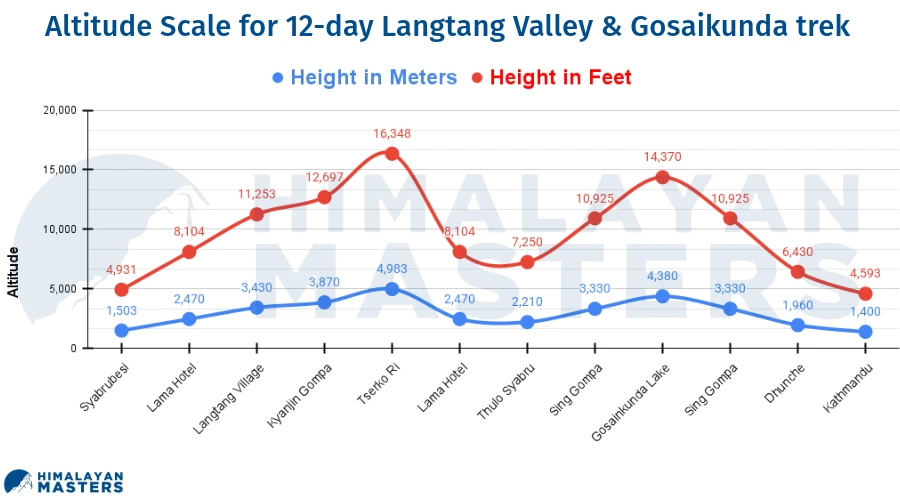
Starting from Dhunche at around 1960 meters (6430 feet), trekkers gradually ascend to higher altitudes, passing through places like Chandanbari (3,330 meters) and Lauribinayak (3,910 meters).
Emergency and Evacuation
Thus, on the Langtang Gosaikunda Trek, it might be worthwhile to mention that there are occasions that can be negotiated to get help and evacuation in cases of troubleshoots. Several trekking companies offer guided treks, some also provide guides on first aid and altitude sickness.
For even more serious circumstances, a helicopter can be hired; for example, at altitude, travellers may experience sickness requiring evacuation or any other difficult circumstance that necessitates air evacuation.
Special Training
In training for the Langtang Gosaikunda Trek, stamina must be trained through cardiovascular activities such as walking, running, and cycling, among others. Some exercises aim at your legs, core, and upper body strength, including squats and lunges.
Gradually increase the frequency of the hikes and the time you use for hiking. If possible, go to high altitudes to get used to the altitude. This is important because one acclimatizes to the load, and stretching exercises are also included to ensure that muscles remain flexible.

Insurance
Trekkers should ensure their insurance includes coverage for altitudes up to approximately 4,400 meters, as most insurers provide this level of coverage.
Costs for such insurance typically range around $75, depending on coverage limits and the trek duration. A trekker must bring travel insurance from their home country.
Roads On Trek And How To Avoid Them
This trek is rated easy to moderate but can include some routes that can be quite tough for individuals. Nevertheless, there are several segments where roads, or at least jeep tracks, are present – mainly at the lowest altitudes.
Of course, there are opportunities to change direction and return to more typical hiking. The right path enables a tourist to avoid too many roads and instead experience the beauty of the Langtang Gosaikunda region.
Kit and Equipment
When preparing for the Langtang Gosaikunda Trek, it’s essential to pack the right gear and equipment to ensure a safe and enjoyable journey. Here’s a list of essential items to bring:
Clothing:
- Waterproof and breathable trekking pants
- Insulating layers (fleece jacket, down jacket)
- Moisture-wicking base layers (long-sleeved shirts, thermal underwear)
- Waterproof and windproof jacket
- Trekking socks (wool or synthetic)
- Sun hat and beanie or warm hat
- Gloves or mittens
Footwear:
- Sturdy and comfortable hiking boots with ankle support
- Trekking sandals
Gear:
- Backpack with rain cover (large enough to carry water, snacks, extra clothing, and personal items)
- Sleeping bag suitable for cold temperatures
- Trekking poles for stability and support on uneven terrain
- Sunglasses with UV protection
- Personal water bottle or hydration system
- Quick-drying towel
- Personal toiletries and medications
- Sunscreen and lip balm with SPF protection
- Insect repellent
Miscellaneous:
- Lightweight and quick-drying towel
- Camera or smartphone for capturing memories
- Power bank or portable solar charger
- Trekking permit and identification documents
- Cash
Accommodation
In the Gosaikunda area, many kinds of accommodations are offered to the trekkers. You can observe lodges, guesthouses, and tea houses along the trek route.
Most of them have shared rooms, whereas certain places have single accommodations. The bathrooms might be attached in larger guesthouses and, more importantly, in Dhunche and Thulo Syabru.
Usually, basic facilities include hot showers; however, they depend partly on the location. Generally, blankets and sleeping bags ensure comfortable sleep.
Amenities Gosaikunda Along the trek to Gosaikunda, you are prepared for several basic amenities. There is internet/Wi-Fi in most of the lodges, but the connection will be very weak since it’s a distant location.
You have charging ports, but keeping a portable charger would be good. You can get clean drinking water, and bottled water can also be bought.
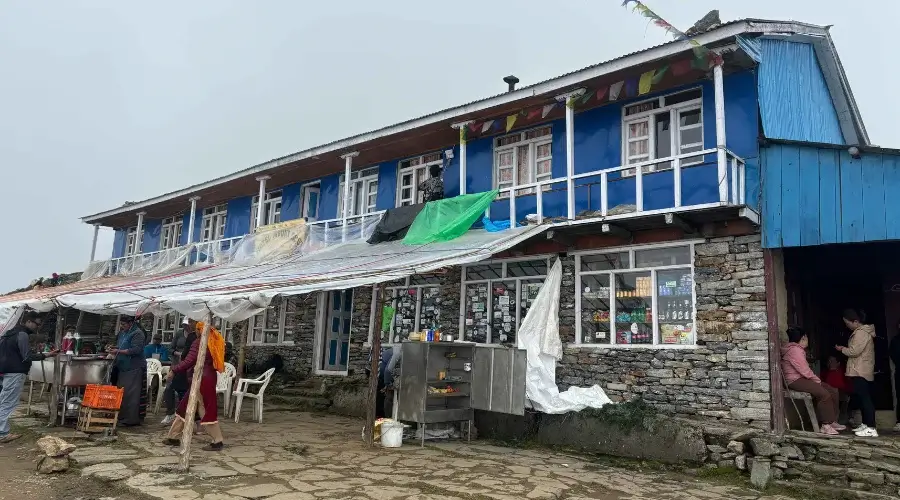
Hotels in the Gosaikunda Lake Area
There are only a few hotels and guesthouses in the area of Gosaikunda. Altogether, about 10 to 15 places offer lodging for trekkers. These are the most comfortable ones in Dhunche and Thulo Syabru, while other stops on the trek have rather basic facilities.
Most of these lodges serve trekkers and pilgrims who visit the holy lakes, especially during the season and the Janai Purnima festival.
Food
You can expect a wide range of food in the Langtang Gosaikunda Trek.
Breakfast:
Choices range from tea or coffee to Tibetan bread, pancakes, porridge, and eggs boiled, fried, or made into an omelette or muesli with hot milk.
Lunch:
Some options are Dal Bhat (rice and lentils with curry), Chow mein (noodles), fried rice, pasta, sandwiches (cheese, eggs, or vegetarian), and soups (vegetarian or noodle).
Dinner:
There are similar options to lunch, with additions such as momos (dumplings), pizza, yak steak (in higher altitudes), and occasionally international dishes like spaghetti.
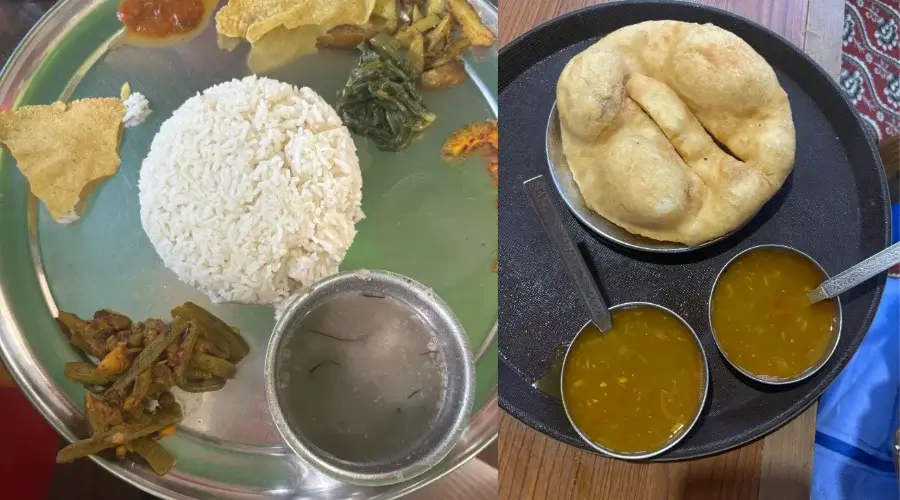
Beverages and Snacks:
Hot drinks like tea, coffee, hot chocolate, soft drinks (Coke, Fanta), bottled water, local alcoholic beverages (beer, Chang), biscuits, chocolate bars, nuts, energy bars, and fresh fruits when available.
ATM and Money Changer
An ATM is available in Syabrubesi, which would be the last point for any cash withdrawal before going on the Gosaikunda trek. It is advisable to carry adequate cash as no ATMs are on the trek route. In Kathmandu, money changers are available, and one can exchange their foreign currency with Nepali rupees.
Guide Vs Solo Gosainkunda Trek
Whether to get the use of a guide or make the trek on your own depends upon your experience. Guides enhance the experience with their local knowledge and make it much safer.
Solo Trekking is good for independence but requires many navigational skills and self-sufficiency. Most trekkers hire a guide for Gosaikunda as it is one of the most remote areas.
Extending Trip
This can be easily combined with other treks like Langtang Valley after completing the Gosaikunda trek. Extra tours involve a sightseeing tour to various cultural sites in Kathmandu Valley. Various trekking companies have also provided options for custom itineraries for extra days for those who want to extend their days.
Distance of Gosaikunda
Gosaikunda from Kathmandu
The distance from Kathmandu to Gosaikunda is about 145 kilometres, about 90 miles. Normally, the journey from Kathmandu to Gosaikunda involves a 6-to-7-hour drive to Dhunche, followed by a trek to Gosaikunda.
Dhunche to Gosaikunda
Via the Gosaikunda trek route, It is about 22 kilometres from Dhunche to Gosaikunda, approximately 13.7 miles. This usually takes 5 to 7 hours, depending on your trekking speed and the trail’s condition. The path goes uphill via attractive landscapes and rhododendron forests.

Communication on Gosaikunda Trek
SIM Cards:
A local SIM card can easily be bought in Kathmandu. However, signal strength remains critical higher up. You can buy Ncell or NTC sim.
Landline Services:
Landline services are available in fewer places; most communication depends on your mobile phone.
Postal Services:
Basic postal services are available in the bigger villages. Letters take many days and even weeks to reach their destinations.
Walkie-talkies:
Some trekking companies may issue walkie-talkies to communicate effectively with team members.
Wi-Fi / Internet
Most of the lodges and teahouses on the trek route also offer internet connection service at small costs. However, it’s not guaranteed to work daily because of weather conditions.
Most of the lodges provide Internet service, which is usable on payment. For emergency purposes, the trekking companies regularly maintain contact with guides and teams using phones.
Electricity and Water
Electricity:
- Most teahouses and lodges provide electricity.
- Exceptions include Lama Hotel, where electricity is not available.
- In Gosaikunda, some places may have limited or no electricity, but several teahouses and lodges use solar panels to charge devices and offer basic amenities like Wi-Fi.
Water:
- Trekkers will find numerous water sources, such as streams and taps, at teahouses and lodges throughout the trek.
- Drink by boiling it or using water purification tablets to ensure safety.
- Refilling reusable water bottles is convenient and environmentally friendly, minimizing single-use plastic bottles.
Alternative Routes for Gosaikunda Trek Nepal
Likewise, the trek to Gosaikunda is also known as Langtang Gosaikunda Trek, but Gosaikunda has many ways. The Helambu Trek starts from Sundarijal or Chisapani, near Kalika, and takes you through the cultural Helambu trek to Gosaikunda.
The other is the culturally rewarding Tamang Heritage Trail, where one can meet the people and even their customs as it connects to Gosaikunda through beautiful, unfamiliar villages.
Always carry a Langtang Gosaikunda Trek map for convenience.
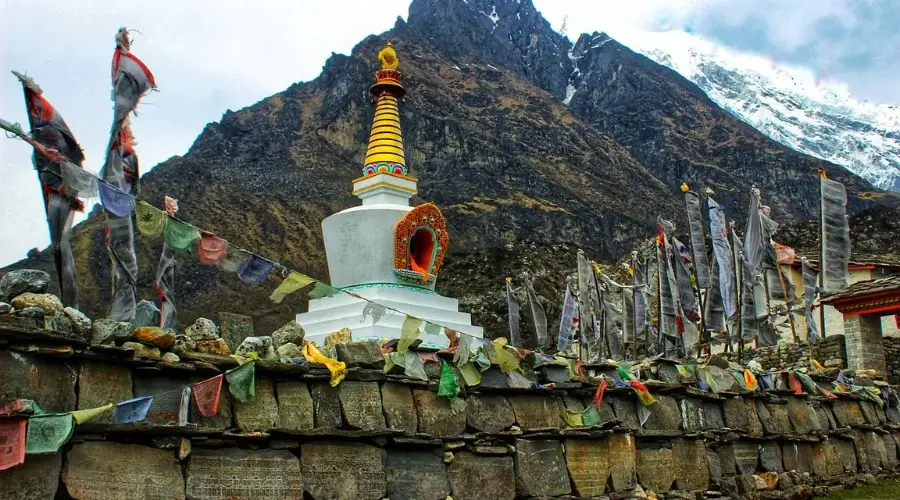
Some More Trek Routes to Gosaikunda Lake
- Kathmandu-Dhunche-Gosaikunda
- Melamchi-Kutumsang-Thadepati-Gosaikunda
- Sundarijal-Kutumsang-Gosaikunda
- Ghyangphedi-Yarsa-Gosaikunda
How to Book Langtang Gosaikunda Trek?
Two options to book a Gosaikunda trek are through trekking agencies and by private reservation. The best option is to pre-book during peak seasons. With Himalayan Masters, the booking process is very hassle-free. You can directly book through the site or mail at [email protected].
Booking Documents
It would be best to have a valid passport, a Trekking Permit for Langtang National Park, and sometimes even a TIMS card. Trekkers’ Information Management System ensures that all these documents are prepared beforehand.
Last-minute Booking
Even last-minute bookings can be made; however, it may be an issue in the case of peak seasons for trekking. The local agencies or guest houses can be contacted directly regarding last-minute arrangements.
Cancellation and Postpone Policy
Himalayan Masters has a non-refundable cancellation policy. With us, your money will not be refunded. But you can visit Nepal anytime and trek with us with the deposited amount anytime for a lifetime.
Feedback and Review
When you get back from trekking, sharing a review of the program helps prospective trekkers make wiser decisions. Himalayan Masters have review options on their websites or via platforms like Tripadvisor.
FAQs
What is the Best time for the trek?
The best time for Langtang Gosaikunda Trek is autumn and spring months. Summer and winter trek is also possible, but you need some preparation before the tour.
What is the accommodation in the Langtang Gosainkunda area like?
The guest houses have a very basic facility, and rooms are available on a sharing basis- two single beds are available in each room. The regions have plenty of hotels in Gosaikunda to accommodate the flow of tourists in the peak season.
What permits do you need for the Langtang Valley Trek?
You will need a TIMS card and Langtang National Park permit.
Is there Wi-Fi/ Internet in Langtang Gosainkunda trek?
The newly built guesthouse mostly has Wi-Fi, but the owner charges you a couple of dollars. However, in the places where Wi-Fi is available, it’s precarious- you wouldn’t be able to do any work other than sending a few texts and photos.
Is Gosaikunda Trek difficult?
Gosaikunda is one of the short and moderate trekking zones of Nepal. While trekking on the initial 2-3 days is quite comfortable, the final climb is known to be difficult.
For an easy trek, you can only check the Langtang Valley trek.
Is Gosaikunda Trek worth it?
A trip to the holy lake of Gosaikunda and an opportunity to witness the beautiful Himalayan range of Nepal within a minimum budget and a few hours of walking are definitely worth it.
What is Gosaikunda famous for?
The famous myth of the Hindu community that connects Gosaikunda to Lord Shiva makes it an important lake in Nepal. On the other hand, Buddhist followers also called it a holy lake. For more than a century, Gosaikunda has been famous as a pilgrim’s tour in Nepal, while it is currently more popular as an adventurous trekking route in Nepal.
What is the myth of Gosaikunda?
As per mythology in the Hindu scriptures, such as Ramayana, Bhagavata Purana, Vishnu Purana and Mahabharata, the Gosaikunda Like was the point for Samudra manthan. It is believed that Shiva had once swallowed the poison that could have destroyed the world and thus saved mankind. After being poisoned, he was very thirsty and pierced a glacier with his trident. And this glacier is said to be Gosaikunda.
On which day do people visit Gosaikunda?
For holy purposes, the lake is visited during the time of Gangadashahara and the Janai Purnima, which is often in June/ July. However, for the trek, autumn and spring months are considered to be better.
Which river is from Gosaikunda?
Trishuli River, which flows west of Kathmandu, mostly along the east-west highway, originated collectively from the Gosaikunda and Naukunda wetlands.
What is the symbol of Gosaikunda?
Gosaikunda is believed to be the symbol of lord Shiva. The large rock in the centre of the lake thus symbolises Shiva.
Which mountain can be seen from Gosaikunda?
The trip to Gosaikunda offers views such as Manaslu, Annapurna, Langtang, Ganesh Himal, and Dhaulagiri. Gosaikunda lies very close to the Langtang Himalaya range, so the view of Langtang Himal from here is quite awesome.
How many days is a trek to Gosaikunda?
With Himalayan Masters the Gosaikunda Trek is of 12 days but if you prefer to do Gosaikunda Trek only it will be shorter.
How far is Gosaikunda from Kathmandu by helicopter?
Gosaikunda is about 65 km north of Kathmandu, the capital city of Nepal. The distance from Gosaikunda to Kathmandu by helicopter is only about 20 minutes.
How far is Gosaikunda from Kathmandu by road?
Gosainkunda is only about 65 km away from Kathmandu. However there is no Road network taking you directly from Kathmandu to Gosaikunda. The nearest distance to Gosaikunda is by bus Dhunche, which is about 46 km. From here, you need to hike for about 25 km to reach Gosaikunda Lake, which usually takes about two days.
How to get Gosaikunda from Pokhara?
From Pokhara, you can get a bus to Kathmandu and then drop off along the east-west highway at the place called Batase. From here, you can get a bus or a jeep to Dhunche. Then, from Dhunche, you trek for 2 days along Sing Gompa to reach the Gosaikunda Lake. Instead of Gosaikunda, you can go to Kapuche Lake from Pokhara in just 3 days.
Is there snowfall in Gosaikunda?
Gosaikunda, a glacier lake at an altitude of 4,460, remains frozen from the month of November to February. Snowfall often occurs in the months of December and January only. For the remaining time of the year, there is no snow in Gosaikunda, and trekking is easier.
Which is the shortest Gosaikunda trek?
The route from Dhunche to Sing Gompa is the shortest route to reach Gosaikunda. For a fast hiker, one half and another full day of walking from Dhuche takes you to Gosaikunda in just two days.
How far is the distance from Sundarijal to Gosaikunda?
It is about 45 kilometres or 28 miles from Sundarijal to Gosaikunda. Normally, it takes six to eight hours, depending on your speed and the situation of the pathway.
How much does the Kathmandu to Gosaikunda Helicopter cost?
The cost of a Kathmandu to Gosaikunda helicopter normally ranges between $300 and $500 per person, depending on the operator and the time of the year.
What is Gosaikunda Mela?
It is a powerful religious festival of Hindus, which takes place every year in the Naag Panchami till Janai Purnima. Thousands of pilgrims come to Gosaikunda at this time to get holy dips in the lake, believing it washes away sins.
What is a 4-day Gosaikunda trek?
A 4-day trek to Gosaikunda normally involves Kathmandu to Dhunche travel, a trek via wonderful scenery, and arriving at Gosaikunda Lake.
How can I go to Gosaikunda from Kathmandu by bus/car?
You can also take a bus or car drive from Kathmandu to Dhunche, which takes around 6-7 hours. From Dhunche, it’s about 22 kilometres of trekking distance to Gosaikunda.
Can I go to Gosaikunda from Kathmandu by bicycle?
Yes, you can ride a bike from Kathmandu to Dhunche, which is about 145 km away. It is a great view, but the conditions of the road really demand good biking skills.
How much depth does Gosaikunda Lake have?
Gosaikunda Lake is about 30 meters deep.
How many lakes (kunda) are there in Gosaikunda?
There are 108 lakes (kundas) in the area of Gosaikunda; many of them are major pilgrimage sites.
Can I bring/operate my drone on the Gosaikunda Trek?
Generally, drones are not allowed in the protected areas of Langtang National Park, to which Gosaikunda belongs. It’s always best to check local regulations beforehand before flying your drone.
Are there any road or vehicle options along the route?
Although there are roads that reach up to Dhunche, there is no transport available from the trek route itself to Gosaikunda; it needs to be trekked.
Can I go on the Gosaikunda trek in the winter?
Yes, you can, however, prepare for extreme cold weather and expect a high chance of snowfall along the trails.
Is there a risk of landslides or avalanches?
Yes, landslides and avalanches are at risk in some parts of the trek, especially in heavy rainfall or snow.